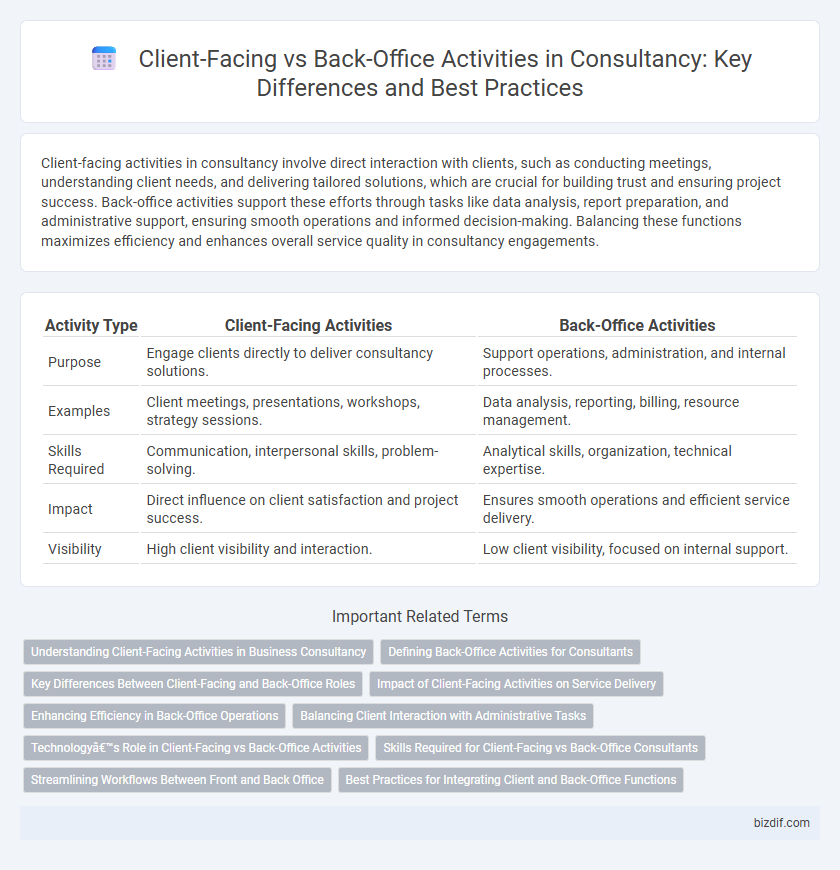Client-facing activities in consultancy involve direct interaction with clients, such as conducting meetings, understanding client needs, and delivering tailored solutions, which are crucial for building trust and ensuring project success. Back-office activities support these efforts through tasks like data analysis, report preparation, and administrative support, ensuring smooth operations and informed decision-making. Balancing these functions maximizes efficiency and enhances overall service quality in consultancy engagements.
Table of Comparison
| Activity Type | Client-Facing Activities | Back-Office Activities |
|---|---|---|
| Purpose | Engage clients directly to deliver consultancy solutions. | Support operations, administration, and internal processes. |
| Examples | Client meetings, presentations, workshops, strategy sessions. | Data analysis, reporting, billing, resource management. |
| Skills Required | Communication, interpersonal skills, problem-solving. | Analytical skills, organization, technical expertise. |
| Impact | Direct influence on client satisfaction and project success. | Ensures smooth operations and efficient service delivery. |
| Visibility | High client visibility and interaction. | Low client visibility, focused on internal support. |
Understanding Client-Facing Activities in Business Consultancy
Client-facing activities in business consultancy involve direct interaction with clients to understand their needs, provide tailored solutions, and foster strong relationships that drive project success. These activities include client meetings, presentations, workshops, and ongoing communication, which are essential for gathering insights and aligning consultancy strategies with client objectives. Mastering client-facing skills enables consultants to deliver personalized value, enhance client satisfaction, and secure long-term business partnerships.
Defining Back-Office Activities for Consultants
Back-office activities for consultants encompass tasks such as project planning, data analysis, report preparation, and internal knowledge management that support client-facing work without direct interaction with clients. These activities ensure operational efficiency, maintain accurate documentation, and facilitate strategy development by providing critical insights and groundwork. Effective back-office functions include resource allocation, compliance monitoring, and internal communication, all essential for seamless client service delivery.
Key Differences Between Client-Facing and Back-Office Roles
Client-facing activities in consultancy primarily involve direct interaction with clients, including presenting solutions, managing relationships, and addressing client needs in real time. In contrast, back-office activities focus on internal operations such as data analysis, report preparation, and project support, ensuring smooth workflow and accuracy behind the scenes. Key differences include communication intensity, with client-facing roles requiring strong interpersonal skills, while back-office roles demand analytical proficiency and process management.
Impact of Client-Facing Activities on Service Delivery
Client-facing activities directly influence service delivery by fostering clear communication, understanding client needs, and building trust, which leads to tailored solutions and higher customer satisfaction. These interactions enable real-time feedback, allowing consultants to promptly adjust strategies and improve project outcomes. In contrast, back-office activities support these processes by managing resources and data efficiently but have less immediate impact on client perception and engagement.
Enhancing Efficiency in Back-Office Operations
Streamlining back-office activities such as data management, compliance monitoring, and internal reporting boosts overall consultancy efficiency by reducing overhead and minimizing errors. Leveraging automation tools and cloud-based platforms enhances process accuracy and accelerates turnaround times for administrative tasks. Optimized back-office operations enable consultants to dedicate more focus to client-facing activities, driving higher client satisfaction and business growth.
Balancing Client Interaction with Administrative Tasks
Client-facing activities in consultancy involve direct interaction with clients, including meetings, presentations, and strategic discussions that drive project success and client satisfaction. Back-office activities encompass essential administrative tasks such as report generation, data analysis, and resource management that support operational efficiency and accuracy. Balancing these activities ensures consultants maintain strong client relationships while managing internal workflows to deliver timely and high-quality solutions.
Technology’s Role in Client-Facing vs Back-Office Activities
Technology enhances client-facing activities by enabling real-time communication, personalized solutions, and seamless collaboration through CRM systems and virtual meeting platforms. In back-office activities, automation tools and advanced data analytics streamline processes such as finance, compliance, and reporting, increasing efficiency and accuracy. The integration of AI and machine learning further optimizes workflow, allowing consultancies to deliver faster insights while maintaining high service quality.
Skills Required for Client-Facing vs Back-Office Consultants
Client-facing consultants require advanced interpersonal skills, including effective communication, active listening, and relationship management to understand client needs and deliver tailored solutions. Back-office consultants need strong analytical abilities, attention to detail, and proficiency in data analysis tools to support strategic decision-making and operational efficiency. Both roles demand problem-solving skills, but client-facing positions emphasize emotional intelligence, while back-office roles prioritize technical expertise and process optimization.
Streamlining Workflows Between Front and Back Office
Streamlining workflows between client-facing activities and back-office operations enhances consultancy efficiency by enabling seamless communication and data flow across departments. Implementing integrated project management tools and automated reporting systems bridges the gap between front office client interactions and back-office administrative tasks. Optimized collaboration reduces bottlenecks, accelerates decision-making, and improves overall client satisfaction.
Best Practices for Integrating Client and Back-Office Functions
Integrating client-facing activities with back-office functions enhances operational efficiency and improves client satisfaction by streamlining communication and data flow. Implementing technologies such as CRM systems and shared project management platforms enables real-time collaboration between sales, customer support, and administrative teams. Establishing standardized processes and regular cross-functional training ensures alignment of objectives and consistency in service delivery throughout the consultancy.
Client-Facing Activities vs Back-Office Activities Infographic

 bizdif.com
bizdif.com